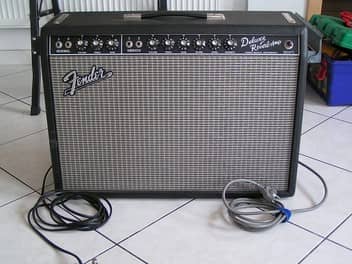
Any guitar lover out there knows that valve/tube amps are made to be cranked.
There is no greater feeling than getting that volume/gain knob all the way up (especially if it can go to 11).
However, we all know very well that our neighbors, our sound guys, even our pets will not appreciate this.
If you have this issue, this is where a guitar amp attenuator will be of great use to you. Let’s jump in…
What is an Attenuator Pedal for a Guitar Amp?
An amp attenuator is a device that allows you to drive your amp harder without getting that insane amount of volume that would naturally come when cranking your amp. This allows you to have total control over your volume without losing the best possible tone out of your amp.
What is an Attenuator Pedal for a Guitar?
Keep in mind that it’s a common fact tube amps sound better when ridden hard. The tone of an amp’s tubes is much richer when there is more wattage coming through them.
An amp attenuator enables you to hit that amp’s sweet spot without losing any control over how loud your sound will be.
This is ideal for home practice sessions and playing at small clubs and venues.
In case you don’t know, an attenuator functions by lowering your tube amps volume while retaining the cranked saturated tone, which is rich in juicy nuances and frequencies. Obviously, because most tube amps sound better when their volume is maxed out.
There are several types of attenuators (which I will discuss later in the article) and different features an attenuator can have.
Some of them only attenuate a signal; others can also boost the signal and give it a character of their own, working as a second preamp.
Some attenuators will also take into consideration factors such as the Fletcher Munson Curve. The Fletcher Munson Curve dictates that a human ear perceives more bass and high frequencies, thus the greater the volume.
Alternatively, the human ear perceives less of both frequencies with less volume. A higher-end attenuator will consider this and add features to increase highs and lows as a countermeasure.
How to Hook Up an Amp Attenuator?
To hook up an attenuator, you would need two speaker cables. In a combo amp situation, you will typically have a built-in speaker cable that connects them. So, you would only need an extra speaker cable.
It is VERY important to understand that you need speaker cables, not instruments cables. If you get instrument cables, the damage will happen, so be on the lookout!
If we were in a combo amp scenario, the first step would be to unplug your cable. Use an external speaker cable to connect from the output of the speaker into the input of the attenuator.
After that, you would reconnect the built-in cable from the amp into the output of the attenuator, often labeled “output to speaker.”
Things to Consider When Buying the Right Amp Attenuator
Two very important factors that you must consider when purchasing an amp attenuator are:
- the output power of your amplifier,
- and its output impedance.
Let’s say you have a 60-watt amplifier, but you purchased a 50-watt attenuator. This will not work and could damage the attenuator (not the amp).
On the other hand, if the ohm impedance between the amplifier and the attenuator does not match (like getting an 8-ohm attenuator for a 16-ohm amp), you could potentially damage the amp.
The best attenuators will have a much higher power attenuator and all-ohm impedance.
The Different Types of Guitar Amp Attenuators
Passive Amp Attenuators
Passive amp attenuators are the simplest ones out there.
they solely rely on weakening the power of the signal and improving the impedance match between the guitar and the amplifier. The goal of this is to reduce volume but still maintain tone successfully.
These types of attenuators are straightforward to use and do not require any sort of external power supply. However, amp damage has been reported in some cases.
This is mostly related to the misuse of the amp attenuator. By cranking the amp to its limit, thus overloading both the amp and the attenuator.
Active Amp Attenuators
Active attenuators do require external power to function. This is because they are designed to not only attenuate a signal but to also boost it.
So essentially, an active attenuator takes a portion of the amp’s signal and can either reduce it or increase it to give it a little more drive.
An active amp attenuator allows you to either tame high-power amplifiers (as a passive attenuator would) or boost low-power amps and give them a little extra oomph.
Resistive vs. Reactive Load
The main difference to be noted between resistive and reactive load attenuators is the fact that a reactive attenuator lowers the amp’s output while maintaining its impedance curve.
It essentially means that regardless of the amount of attenuation, your tone will maintain as much transparency as possible.
Resistive attenuators don’t maintain that impedance curve, and as attenuation increases, the color of your tone changes, becoming more compressed and darker.
Do Attenuators Affect Tone?
Not necessarily, but this will depend on the quality of the amp attenuator. On one hand, any piece of gear added to your signal chain will affect the tone in some way.
Some attenuators are designed to have some sort of “color” to enhance the tone of your amp. Most attenuators won’t be like this, and the higher-end products are designed to be as transparent as possible.
The most noticeable tonal change is the one I mentioned previously with the Fletcher-Munson curve.
A healthy human ear perceives a frequency range of 20-20K Hz. The most noticeable frequencies to a human ear are from about 2K-5K, which is considered to be in the mid-high range of the spectrum.
The Fletcher-Munson curve suggests that changes in volume affect the perception of everything above and below the 2K-5K ranges.
If volume increases, you will hear more of the frequencies outside that range (lows and highs). If volume decreases, you will perceive less.
So, in reality, it is not a change of tone that happens; it is a change of frequency perception due to volume decrease.
Do Amp Attenuators Degrade Sound Quality?
Think of it this way:
Attenuators are like any other piece of gear, amp, or guitar you might be thinking of purchasing.
The cheaper the product, the more likely its quality will not be as good. On these terms, then yes, a low-quality attenuator will degrade sound quality.
What might be perceived as degradation in sound quality can be the improper use of an attenuator.
For example, if you were to max crank an amp’s gain and then considerably lower its volume, you might get an overly distorted, thin sound.
This is not because the quality of the attenuator/amp is terrible. It is just an improper use of the balance between gain and volume. With distortion pedals, this can also be a widespread occurrence.
It is quite an art to dial in the right amount of juice to your sound, but open ears and practice are the way to go.
Will an Attenuator Damage My Amp?
One of the most common questions and also one of the most common misconceptions is that you risk damaging your amp if you use an attenuator.
Bear in mind this is simply not the case. As long as you get the right attenuator that matches the power voltage and impedance of your amp, you should have no problem.
It is also a good idea to make sure your amp attenuator does not overheat, but good quality attenuators will have a built-in fan as a precaution.
This myth is more closely related to tube damage, but this is not exactly tube damage perse. Essentially, your intention with getting an attenuator is to get that driven tube sound that is so warm and sweet without the exceeded volume.
Using an attenuator can indirectly make your tubes work harder for longer periods of time, which will cause them to wear down more quickly.
There is not much you can do about this, but to be conscientious of how hard you drive your tubes and for how long.
What is a fact is that tubes wear down and after a while, they will begin to distort in a not so nice way. However, this brings no risk to the amp itself.
Cheap vs Expensive Amp Attenuators?
The main differences between cheap and expensive attenuators come to the features that they will have. Cheap attenuators will be passive attenuators and will usually have less power of attenuation.
Cheap attenuators will also most likely only have a volume control without any tonal compensators.
As for tone, there will naturally be a slight decrease in fidelity with cheaper attenuators, but nothing noticeable enough to increase the price dramatically.
There is a great video that compares a $100 attenuator vs. a $500 attenuator so you can compare their quality and make your own decision.
$100 Attenuator vs $500 Attenuator (Comparision Video)
The Best Guitar Amp Attenuators
1. Rivera Rock Crusher – Proven & Popular
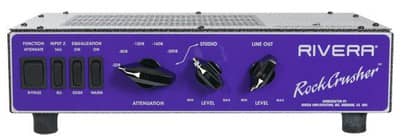
The Rivera Rock Crusher is one of the best attenuators out there. To start, it has both 8-ohm and a 16-ohm mode, which allows you to use it with any amplifier.
Tonally speaking, it is a very transparent attenuator, and it provides volume reduction that ranges from 3dB to 20dB.
It also comes with an extra volume knob to control your volume even further. It also comes with two equalization switches that can add warmth or high-end edge to compensate for the Fletcher-Munson curve.
I would also add that there is a higher-end version of the Rivera Rock Crusher that also has an 11-Band EQ Speaker that gives you even more control over your tone.
Guaranteed, it makes it pricier, but the amount of control over your sound you’ll attain is incredible.
2. Two Notes Torpedo – Proven & Popular
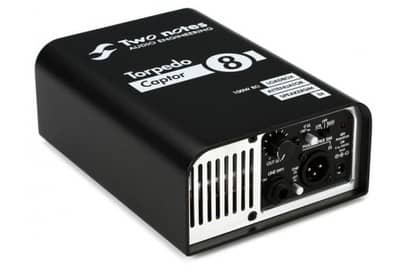
The Two Notes Torpedo is a combination of many devices with different functions.
It serves as a power attenuator, but also as a multi-impedance load box (which allows you to use it with any amplifier), a DI, and a re-amping box.
It also comes with the “Torpedo Wall of Sound,” which is a software where you can do all of the re-amping of your signal.
This software comes with 24 different amp cabinets and multiple parameters to practically change your sound in any way possible.
Tone-wise it must be said that transparency is a big plus. The Two Notes Torpedo is also designed not to affect your tone in any way, maintaining total reliability to your sound.
It also comes with a contour knob to adjust your tone and counter the Fletcher-Munson curve I’ve talked so much about.
3. Bugera Power Soak – Best Budget Option
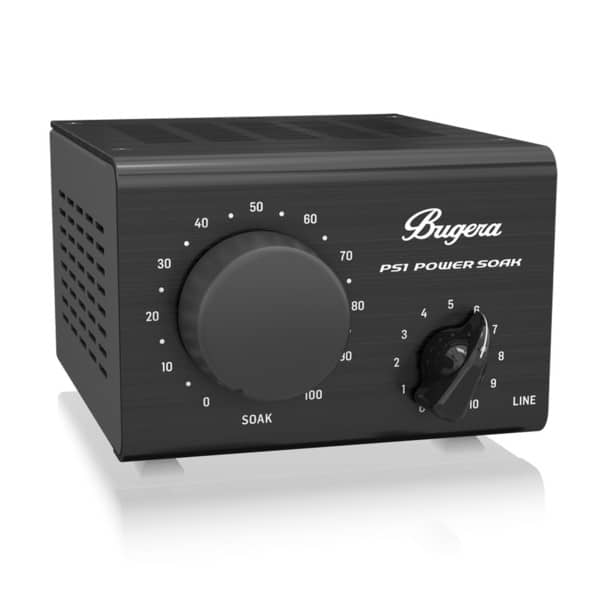
The Bugera Power Soak is probably the best-quality, low-budget attenuator on the market.
It has a reasonably simple setup, but the transparency of attenuation you get from this piece of gear matches the high-end attenuators that compete with it.
The Bugera Power Soak is a 100W passive attenuator with a 4,8 and 16ohm impedance to match any amplifier.
It comes with two volume knobs to fine-tune the final output volume of your sound.
Finally, it has a mic emulator output to replicate the sound of a mic’d amp. It is most likely the best choice for anyone who is budget conscientious.
4. Electro-Harmonix Nano Signal Pad – Most Compact
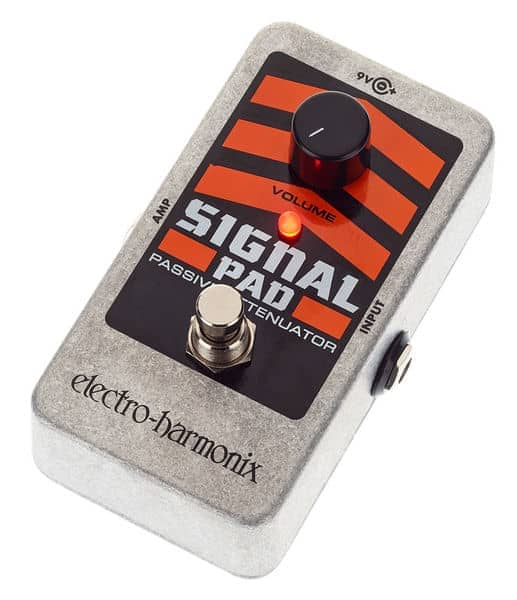
This one is slightly different than all of the other attenuators. This one is actually a guitar pedal, rather than an independent power unit.
This means it can be added to your pedalboard but more importantly, it doesn’t attenuate the signal from your amplifier, but from your guitar.
In essence, it provides the same result; the only downside is that the fidelity of sound might decrease a bit.
Nevertheless, the Electro-Harmonix Nano Signal Pad is an excellent choice for an even lower price than the Bugera Power Soak, and it is much easier to carry around.
Related Questions
Can you use a volume pedal as an attenuator?
Unfortunately, a volume pedal will not have the same effect as an attenuator. The reason is that a volume pedal works as a master volume control. It means that the volume attenuation will come after the preamp. An attenuator works the way it does because it comes before the preamp.
Can you place an attenuator pedal in effects loop?
There are some attenuator pedals such as the Leech Passive Volume Attenuator, or the Electro-Harmonix Nano Signal Pad we just reviewed that are placed in your effects loop. These pedals should not be put between your speaker and your cabinet. You will damage them and potentially your amp.
Can you use an attenuator with a combo amp?
Yes, you can. The only difference is that the built-in speaker cable will be reconnected from the amp head into the attenuator. From there, you’d need an extra speaker cable to connect the attenuator to the amp speaker. Everything else will work the same way as it would on an amp head/cabinet situation.
Do attenuators really work?
Yes, they do. An attenuator is an excellent choice for anyone who has a high-power amp and wishes to get the full tone it provides while also being able to control the volume of their sound. An investment worth looking into.
Final Thoughts
Although attenuators have been around since the 70s, it seems that we have finally caught on to the truth that we can get the most out of our amps, without destroying our ears or our relationships with our neighbors.
I can confidently say, an amp attenuator can potentially be an instrumental piece of gear for playing your prized tube amp with total control over volume and tone.
Check Out My Next post
Does your tube amp unexpectedly sound terrible?
Do you know how to determine a faulty tube amp? Then you have to read my next post…

